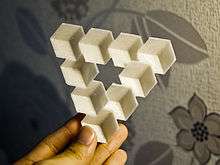Impossible object
An impossible object (also known as an impossible figure or an undecidable figure) is a type of optical illusion. It consists of a two-dimensional figure which is instantly and subconsciously interpreted by the visual system as representing a projection of a three-dimensional object.
In most cases the impossibility becomes apparent after viewing the figure for a few seconds. However, the initial impression of a 3D object remains even after it has been contradicted. There are also more subtle examples of impossible objects where the impossibility does not become apparent spontaneously and it is necessary to consciously examine the geometry of the implied object to determine that it is impossible.
The unsettling nature of impossible objects occurs because of our natural desire to interpret 2D drawings as three-dimensional objects. This is why a drawing of a Necker cube would be most likely seen as a cube, rather than "two squares connected with diagonal lines, a square surrounded by irregular planar figures, or any other planar figure." With an impossible object, looking at different parts of the object makes one reassess the 3D nature of the object, which confuses the mind.[1]
Impossible objects are of interest to psychologists, mathematicians and artists without falling entirely into any one discipline.
Notable examples
Notable impossible objects include:
- Impossible cube — The impossible cube was invented by M.C. Escher for Belvedere, a lithograph in which a boy seated at the foot of the building holds an impossible cube.[2][3]
- Penrose stairs — The Penrose stairs was created by Lionel Penrose and his son Roger Penrose.[4] A variation on the Penrose triangle, it is a two-dimensional depiction of a staircase in which the stairs make four 90-degree turns as they ascend or descend yet form a continuous loop, so that a person could climb them forever and never get any higher.
- Penrose triangle (Tribar) — The Penrose triangle was first created by the Swedish artist Oscar Reutersvärd in 1934. The mathematician Roger Penrose independently devised and popularised it in the 1950s, describing it as "impossibility in its purest form".
- Impossible trident (or devil's tuning fork) — The Blivet has three cylindrical prongs at one end which then mysteriously transform into two rectangular prongs at the other end.[5]
| Examples of impossible objects | ||||||||||
|---|---|---|---|---|---|---|---|---|---|---|
|
History
An early example of an impossible object comes from Apolinère Enameled, a 1916 advertisement painted by Marcel Duchamp. It depicts a girl painting a bed-frame with white enamelled paint, and deliberately includes conflicting perspective lines, to produce an impossible object. To emphasise the deliberate impossibility of the shape, a piece of the frame is missing.

Swedish artist Oscar Reutersvärd was one of the first to deliberately design many impossible objects. He has been called "the father of impossible figures".[6] In 1934 he drew the Penrose triangle, some years before the Penroses. In Reutersvärd's version the sides of the triangle are broken up into cubes.
In 1956, British psychiatrist Lionel Penrose and his son, mathematician Roger Penrose, submitted a short article to the British Journal of Psychology titled "Impossible Objects: A Special Type of Visual Illusion". This was illustrated with the Penrose triangle and Penrose stairs. The article referred to Escher, whose work had sparked their interest in the subject, but not Reutersvärd, of whom they were unaware. The article was published in 1958.[4]
From the 1930s onwards, Dutch artist M.C. Escher produced many drawings featuring paradoxes of perspective gradually working towards impossible objects.[6] In 1957, he produced his first drawing containing a true impossible object: Cube with Magic Ribbons. He produced many further drawings featuring impossible objects, sometimes with the entire drawing being an impossible object. Waterfall and Belvedere are good examples of impossible constructions. His work did much to draw the attention of the public to impossible objects.
Some contemporary artists are also experimenting with impossible figures, for example, Jos de Mey, Shigeo Fukuda, Sandro del Prete, István Orosz (Utisz), Guido Moretti, Tamás F. Farkas and Mathieu Hamaekers.
Constructed impossible objects
Although possible to represent in two dimensions, it is not geometrically possible for such an object to exist in the physical world. However some models of impossible objects have been constructed, such that when they are viewed from a very specific point, the illusion is maintained. Rotating the object or changing the viewpoint breaks the illusion, and therefore many of these models rely on forced perspective or having parts of the model appearing to be further or closer than they actually are.
The notion of an "interactive impossible object" is an impossible object that can be viewed from any angle without breaking the illusion.[7]

See also
References
- ↑ "Impossible Figures in Perceptual Psychology". Fink.com. Retrieved 11 February 2014.
- ↑ Bruno Ernst (Hans de Rijk) (2003). "Selection is Distortion". In Schattschneider, D.; Emmer, M. M. C. Escher's Legacy: A Centennial Celebration. Springer. pp. 5–16. ISBN 978-3-540-28849-7.
- ↑ Barrow, John D (1999). Impossibility: The Limits of Science and the Science of Limits. Oxford University Press. p. 14. ISBN 9780195130829.
- 1 2 Penrose, LS; Penrose, R. (1958). "Impossible objects: A special type of optical illusion". British Journal of Psychology. 49 (1): 31–33. doi:10.1111/j.2044-8295.1958.tb00634.x. PMID 13536303.
- ↑ "Impossible Fork". Wolfram Research. Retrieved 10 February 2014.
- 1 2 Seckel, Al (2004). Masters of Deception: Escher, Dalí & the Artists of Optical Illusion. Sterling Publishing Company. p. 261. ISBN 1402705778.
- ↑ Khoh, Chih W.; Kovesi, Peter (February 1999). "Animating Impossible Objects". Retrieved 10 February 2014.
Further reading
- Bower, Gordon H. (editor), (1990). Psychology of Learning & Motivation. Academic Press. Volume 26. p. 107. ISBN 0080863779
- Mathematical Circus, Martin Gardner 1979 ISBN 0-14-022355-X (Chapter 1 – Optical Illusions)
- Optical Illusions, Bruno Ernst 2006 ISBN 3-8228-5410-7
External links
| Wikimedia Commons has media related to |
- Impossible World
- The M.C. Escher Project
- Art of Reutersvard
- "Escher for Real" (3D objects)
- Inconsistent Images




